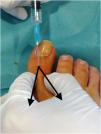Onychocryptosis is a common nail disorder that usually affects the great toe and is characterized by swelling and severe pain.1,2 The most common treatment is partial avulsion (matricectomy) using different surgical techniques. Before surgery, complete anesthetic block is required.
The most commonly used anesthetic block technique is the ring or H technique.3 This technique requires several punctures. The V technique was described in 2017.4 It is less well known and allows digital anesthetic block with a single puncture.
The objective of this article is to increase awareness of the V technique in order to promote its use.
Nineteen patients (7 men and 12 women) were recruited for this study (number of affected nails, 25). The patients ranged in age from 12 to 89 years (mean, 48.6 y; range, 12–89 y). Patients with contraindications such as coagulation disorders, diabetes mellitus, and a history of sensitivity/allergy to anesthesia and those with cognitive deficits were excluded. Anesthetic block of the great toe was achieved using the V technique.
The procedure was performed at the SS podiatry clinic and the podiatry outpatient clinic at the Hospital Clínic de Barcelona. Ethical approval was obtained from the ethics committee of the University of Barcelona (IRB00003099) and the Hospital Clínic de Barcelona (HCB/2019/0051). Written informed consent was obtained before planning the intervention.
With the patient on a bed, the foot relaxed, the base of the proximal phalanx of the great toe was located and the dorsal area gently pinched with the fingers. The needle (0.6mm×25mm) was inserted below the dermis and 1mL of anesthetic injected (Fig. 1). Next, without withdrawing, the needle was moved laterally towards the metatarsophalangeal joint in the first interdigital space and 2mL of anesthetic injected.
Once anesthetic blockade of the lateral aspect of the great toe was performed, the same maneuver was repeated to achieve medial blockade, again injecting 2mL of anesthetic. Efficacy was evaluated 10 and 20minutes after performing the V technique. To assess anesthesia the toe was pinched with tweezers and the patient was asked about the lack of sensitivity and sensations of numbness or pain.
Use of the V technique in 25 great toes resulted in effective anesthesia within 10minutes in 15 patients (60%) and within 20minutes in 21 patients (84%). Additional anesthesia was required in 4 patients.
Onychocryptosis is a very painful nail condition. Treatment is usually conservative, although sometimes surgery is required.1,2
In all cases in which surgery is required, correct anesthetic block of the toe must be performed: the 2 dorsal digital nerves and the 2 plantar digital nerves must be anesthetized.
The most commonly used method to achieve anesthesia is the H technique, first described by Frost in 1952, in which 2 punctures are made at the base of the proximal phalanx (one on each side) and the needle is moved laterally and dorsally to administer an additional dose of anesthetic.3 The V technique is a lesser known method, first described in 2017.4 The main advantage of the V technique is that anesthetic block of the toe can be achieved with a single puncture, followed by 2 lateral movements of the inserted needle.4,5 While this technique can also be used to achieve anesthetic block of the second to fifth toes,6 in this study we used it only on the great toe, which is the digit most commonly affected by onychocryptosis.
Complete anesthetic block was achieved in 21 of 25 toes anesthetized using the V technique. No adverse effects were detected. To our knowledge, no other studies have evaluated the efficacy of this technique, or compared its efficacy with that of other techniques. Therefore, we cannot claim that this method is superior to others. However, we believe that the V technique may be better tolerated by patients, as it requires only a single puncture, thereby reducing anxiety and fear of the pain caused by the injection procedure.
The V technique can be used as an alternative to other anesthetic block techniques, and is a safe and effective method for onychocryptosis surgery.
FundingThe authors have no sources of funding to declare.
Conflicts of InterestNone.








